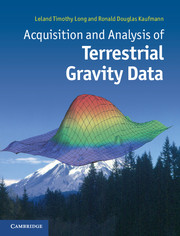Book contents
- Frontmatter
- Contents
- Preface
- 1 Gravitational attraction
- 2 Instruments and data reduction
- 3 Field acquisition of gravity data
- 4 Graphical representation of the anomalous field
- 5 Manipulation of the gravity field
- 6 Interpretation of density structure
- 7 The inversion of gravity data
- 8 Experimental isostasy
- A Appendix ACommon definitions and equations in potential theory
- B Appendix BGlossary of symbols
- References
- Index
4 - Graphical representation of the anomalous field
Published online by Cambridge University Press: 05 February 2013
- Frontmatter
- Contents
- Preface
- 1 Gravitational attraction
- 2 Instruments and data reduction
- 3 Field acquisition of gravity data
- 4 Graphical representation of the anomalous field
- 5 Manipulation of the gravity field
- 6 Interpretation of density structure
- 7 The inversion of gravity data
- 8 Experimental isostasy
- A Appendix ACommon definitions and equations in potential theory
- B Appendix BGlossary of symbols
- References
- Index
Summary
Map scale and implied accuracy
Gravity data are usually presented in a graphical mode as a contour or relief map. The contour map may be color coded to indicate the magnitude of the anomaly. Also, the contours may be shaded to simulate a low angle of illumination or displayed as a surface to provide a three-dimensional visualization of the data (Figure 4.1). Such presentations facilitate visual perception of the shape and trends of the potential field. Color coding and shading have the advantage of minimizing the mental effort needed to convert contour lines and point plots of data to a visual image of the surface. The similarity of this image to the familiar presentation of topography facilitates interpretation and identification of anomalies. With an understanding of how density anomalies contribute to the anomalous field, observed anomalies can be translated into estimates of structures that ultimately lead to more quantitative interpretations of structure.
Often, access to an area is limited and in order to obtain sufficient detail for interpretation, the data are obtained along lines and projected onto straight-line profiles that are approximately parallel to the line. These slices through the gravity field of a study area can be analyzed in more detail and provide interpreted information more quickly than from the larger data set required to cover a two-dimensional area. Whether it is a line of closely spaced data or a section drawn through a two-dimensional map, these one-dimensional profiles generally require that the trend in the anomalies be known before an analysis is started. Applications of two-dimensional models require that the slices be projected onto a line perpendicular to the trend of the structure.
- Type
- Chapter
- Information
- Acquisition and Analysis of Terrestrial Gravity Data , pp. 48 - 68Publisher: Cambridge University PressPrint publication year: 2013



